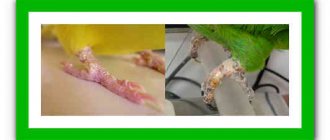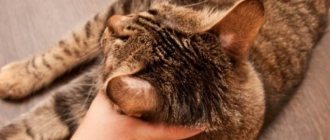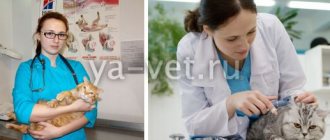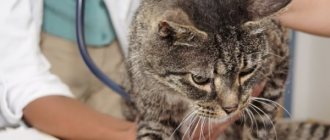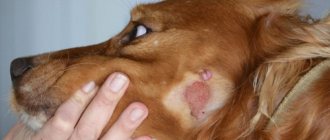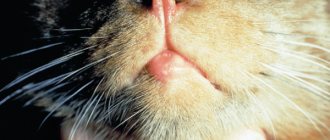Nematodosis is one of the most common diseases of cats and dogs. It can be caused by roundworms of several varieties. For example, quite often pets become infected with helminths of the Ancylostomatidae family, which affect the small intestine. Of course, the appearance of a parasite such as hookworm in an animal’s body requires the immediate adoption of certain measures. In cats, as in people, this disease is treated primarily with the use of special medications.
Description of the parasite
The length of the thin hookworm nematode (Ancylostoma) in some cases can reach 21 mm. In the oral capsule of each such worm there are two hard horny plates with three hooked teeth at the edges. The eggs of this parasite containing blastomeres are gray in color and oval in shape. Their dimensions are approximately 0.06x0.05 mm.
Once settled in the small intestine, the worm begins to actively feed on the animal’s blood. In the oral cavity, the hookworm, among other things, produces a secretion that prevents it from coagulating. Therefore, the wounds left by parasites continue to bleed for a very long time.
Female hookworms are much larger than males. These parasites feel very good not only in the air or in the soil, but also in water. Even the larvae of this parasite usually migrate only during rain.
Hookworm disease can affect both cats and dogs. In the first case, the disease is usually caused by worm species such as Ancylostoma tubaeforme and Ancylostoma braziliense. Sometimes cats become infected with the “canine” variety of hookworm - Ancylostoma caninum. Unfortunately, such worms especially often affect young animals.
Hookworm in dogs
Hookworm infection in dogs. Hookworm is a helminthic pathology caused by roundworms of the genus Ancylostoma. The localization of parasitism of these pathogens is considered to be the small intestine of animals. Hookworms are small in size. At their head end there is a powerfully pronounced capsule. There are 6 large teeth located on the anterior edge of the capsule. The length of females of such worms can reach 22 mm. Males have half the body length.
Hookworm infection in dogs. First, hookworm eggs are released into the environment with the feces of infected dogs. If conditions are favorable, larvae emerge from the eggs after some time. They acquire the ability to infect animals through the process of double molting. This takes approximately 6-8 days. Hookworms can enter a dog's body either through the mouth or through the skin.
Typically, hookworm parasitizes the wall of the small intestine. However, some of the larvae enter the systemic circulation. As a result, they affect many organs and tissues. This is accompanied by the occurrence of organ hemorrhages and the formation of parasitic granules. After this, the pathogen dies.
There is evidence of the possibility of intrauterine infection of puppies. In the body of dogs, the hookworm turns into a sexually mature individual. The duration of this process is about 15 days. The lifespan of this worm can reach 100 weeks.
Eggs and all stages of hookworm larvae are sensitive to desiccation. However, in places with high humidity they can last up to 7 months.
Clinical picture of the disease
Hookworm infection in dogs. The penetration of larvae into a dog's body through the skin is accompanied by the development of a local skin reaction. In this case, as a rule, urticaria develops. There is significant injury to the intestinal mucosa by sexually mature individuals. The development of anemic disorders is also characteristic. This is due to the parasites feeding on blood.
Hookworm infection occurs in dogs of all ages. Intrauterine infection, in most cases, is manifested by severe anemia and coma, developing within 20 days after the birth of animals. All dogs with hookworm infection are anemic. It is also possible for the dog to experience general weakness, swelling and depression. Dermatitis may appear on the skin. As a rule, the cause of death in animals is progressive weakness and severe pallor of the mucous membranes.
Symptoms and diagnosis of the disease
The diagnosis of pathology is based on characteristic clinical symptoms and the detection of hookworm eggs in the stool. A post-mortem diagnosis requires the presence of pronounced changes in the small intestine and the identification of sexually mature parasites.
Treatment of hookworm in dogs
Hookworm infection in dogs. To treat this pathology, you can use naphthamon and tenium. These drugs are recommended to be given to the animal with food. Minced meat is best suited for this.
Avermectins and benzimidazoles are also prescribed. These drugs are used to combat ascariasis. However, they are also effective against hookworm.
Treatment of anemic disorders is provided. For this purpose, blood transfusions and the administration of iron-containing drugs (ferrodex) are carried out.
Prevention of hookworm
To prevent the development of hookworm, it is recommended to regularly deworm weaned puppies. Adult animals are subject to such treatment once a quarter. It is necessary to constantly wash floors and enclosures with water with the addition of regular salt. This contributes to the death of the larvae. You can also use a borax solution.
Hookworm infection in dogs. Hookworms, commonly called hookworms - Ancylostoma and Uncinaria - are the most common intestinal parasites in cats (especially kittens). May cause severe illness, including anemia and severe diarrhea. They got their name from the English Hook. The fact is that they have special tooth-like hooks with which the worms attach to the intestinal walls. Worms feed on animal blood.
Routes of infection
Hookworm can appear in the body of cats due to improper feeding or during a walk. Infection occurs most often:
- through food or water;
- through the skin (usually on the paws);
Once the larvae enter the animal's body through food or drink, they remain in the small intestine and immediately begin to develop rapidly. They reach sexual maturity approximately 2 weeks after infection.
The larvae that have entered the cat’s body through the skin first enter its trachea through the bloodstream. Due to the irritation of the latter, the cat, of course, begins to cough. As a result, the larvae first enter the animal’s oral cavity, and from there into its small intestine. With this method of infection, hookworms reach sexual maturity only on days 18-22. Most often, cats are infected with this type of nematode, unfortunately, through the skin.
A feature of worms of the Ancylostoma class, among other things, is that they can also infect the fetus in the womb. In dogs, for example, this happens quite often. However, fortunately, there have never been any cases of infection of embryos in the mother’s uterus in cats. This is primarily due to the behavior of the worm inside the animal.
Development cycle
Female hookworms (and one animal can have hundreds of them) secrete several thousand eggs every day, which enter the external environment with the cat’s feces. The eggs are invisible to the naked eye. The larvae emerge from them in the external environment, and they can live in the soil for a very long time. Infection occurs when a cat licks its paws. The larva enters the intestine, where it begins to intensively feed and grow. It takes approximately 2-3 weeks for it to fully grow and become a sexually mature individual.
Indirect symptoms of the disease
This is how hookworm appears in cats (a photo of this worm can be seen on the page) in the body. It is possible to accurately diagnose the presence of the parasite in these animals, as in any other, only in laboratory conditions, in a veterinary clinic. Ancylostoma caninum infection is determined first of all by testing the animal's stool to determine the presence of parasite eggs. However, this disease, of course, also has indirect symptoms. These include:
- lethargy and lack of appetite;
- constipation or diarrhea;
- weight loss;
- poor hair condition;
- vomiting
Very often, the feces of cats infected with hookworms take on a dark tar color. In this case, bright red inclusions may be noticeable in the feces. The latter are blood from wounds left by parasites in the intestines.
Hookworm in cats, the symptoms of infection of which are quite pronounced in many cases, sucking the blood of the animal, for obvious reasons, can also cause anemia. Therefore, if you suspect an infection, your pet’s gums, among other things, should be examined. In sick cats, they usually become pale and dull.
Also, if you suspect an Ancylostoma infection, experts advise carefully examining your cat’s paws. When the parasite enters the animal’s body from grass or soil, it leaves wounds on the skin that take a long time to heal. In kittens, symptoms of hookworm infection may also include developmental delays and dull coats.
Clinical symptoms
The main symptom of hookworm infection is anemia, characterized by the following symptoms:
- lethargy;
- lack of appetite;
- weight loss or growth failure;
- pallor of the mucous membranes, this is especially noticeable when examining the mouth;
- intestinal disorders;
- cough;
- vomit;
- feces are dark-colored, which indicates intestinal hemorrhages;
- six loses its shine and becomes unkempt;
- the paw pads bleed and become inflamed.
Kittens suffer more than adults.
Features of the course of the disease
Hookworm behaves in a cat’s body somewhat less actively than in a dog. This is why intrauterine infection of the fetus never occurs in these animals. However, hookworms can penetrate into the mammary glands through the bloodstream, including in cats. In this case, newborn kittens will definitely become infected from their mother through milk.
Pathogenesis
Hookworms have sharp teeth, with which they drill through the mucous membrane and walls of small vessels. To prevent the blood from clotting, the helminths inject an anticoagulant into the wound. With severe intestinal infestation, anemia develops.
Crowded housing, especially in the conditions of a stray cat nursery, contributes to the widespread infection of animals.
Features of the development of the parasite
Once worms enter a cat's intestines, they first begin to feed on its tissues. Also, larvae can “graze” on the mucous membrane. Parasites do not cause any particular harm to the cat’s body during this period. However, after a few days the larvae grow up and begin to feed directly on the animal’s blood. At this time, the first symptoms of infection with a parasite such as hookworm appear in cats. A photo with the names of the stages of larval development (picture) can be seen just below.
In small kittens, the disease occurs a little differently than in adult animals. The first external signs of infection usually appear before the parasites reach sexual maturity and eggs appear in the feces.
Treatment of cats
Treatment of hookworm in cats is carried out only by a veterinarian, who will determine a treatment plan based on the symptoms described, as well as the results of stool and blood tests. The basis of therapy for hookworm infection is drugs that have pronounced anthelmintic activity. It is important to understand that the choice of medication depends on the degree of progression of the disease and the age of the animal. The most popular drugs to combat hookworm in veterinary medicine are:
- “Prazatsid” and “Dirofen” are available in the form of a suspension, which is why they are especially often used to treat kittens over 3 weeks of age.
- "Drontal" and "Dirofen" are tableted anthelmintic drugs approved from the age of 4 weeks.
- Milbemax is another effective remedy that can be given to cats at least 6 weeks old.
- “Febtal” (tablets) or “Prasitel” (suspension) are effective drugs in the treatment of hookworm infection, used in animals aged 6 weeks and older.
It is also important to understand that treatment of the disease must be carried out in several successive courses. The first course of drug therapy eliminates living hookworms. The second course is carried out 2-3 weeks later, during this period new larvae hatch from the eggs, which also must be destroyed so that the parasite population does not resume.
Know!
The medications and treatment plan are determined by the veterinarian.
In some cases, it is even better to leave your pet at the clinic, where they will take care of it and make sure that the animal takes its medications according to the schedule.
Preventive actions
As for the prevention of hookworm infection, it begins from the moment the kitten turns 3 weeks old. Subsequently, veterinarians advise deworming regularly, at least twice a year. If the cat regularly goes outside, deworming should be done every 3 months. In addition, it is important to follow the following recommendations from veterinarians:
- Correction of the diet - you should not feed the animal raw food, it is important to at least pour boiling water over all foods before eating.
- Water – It is not recommended to give boiled water to cats, but tap water is also not suitable. The best option is distilled water, which should be changed regularly.
It is important to understand!
For ideal prevention, it is necessary to minimize the cat’s contact with other animals that do not live in the same apartment.
Features of treatment
So what should owners do if they detect the presence of a parasite such as hookworm in cats? A photo of these worms can, of course, even frighten an inexperienced person. The nematodes of this group look really scary. However, fortunately, hookworm does not fall into the category of incurable diseases. It is quite possible to rid an animal of parasites even in a short time. To do this, you just need to choose the right treatment method.
At a veterinary clinic, a sick cat is usually prescribed special antihistamines, and a special maintenance diet is also developed for it. Animals infected with hookworms lose weight very quickly. Therefore, their menu must include foods containing large amounts of proteins.
The presence of this type of nematode in a cat’s body, as already mentioned, almost always leads to anemia. Therefore, the diet of a sick animal, among other things, includes foods containing iron. In the most severe cases, when acute anemia cannot be eliminated with the help of food and medicine, the furry patient may even be prescribed a procedure such as a blood transfusion.
Treatment of hookworm
Despite the danger of the pathology, it is easily treatable. Especially when parasites are detected at an early stage of their development.
Basic rules of treatment:
- A sick pet should be isolated from healthy animals while fighting the disease.
- Both medications and traditional recipes are used.
- New generation anthelmintic drugs contain either one active ingredient, the action of which is aimed at combating a specific helminth, or several. Since a pet is often infected with several parasites at the same time, it is advisable to choose a multifunctional product.
- In parallel with therapy, the animal should be switched to therapeutic food. This measure will help cope with anemia.
- Veterinarians recommend using medications containing iron, folic acid and B vitamins. Taking these medications helps restore red blood cells and stimulates the hematopoietic organs.
- 1 month after the end of treatment, you need to do a repeat stool examination. If helminths are found in the feces, undergo a second course of therapy using a different anthelmintic drug.
If the disease progresses to an acute stage, a blood transfusion may be required.
Folk remedies
Home medicine recipes are not as effective as pharmaceutical products. However, they can be used as a concomitant treatment.
- Sugar cubes. Give it to your pet several times a day, mixing it with food or pouring a sugar solution into the esophagus using a syringe.
- A decoction of chamomile or fennel. Brew 25 mg of the collection in 250 ml of boiled water and give it to drink instead of drinking water.
- Onion. Cut the vegetable into 4 parts, pour 1 glass of warm water and give in the morning on an empty stomach.
- Infusion of common tansy. 1 tbsp. pour 250 ml of boiling water over the flowers and leave. Give 3 times a day 30 minutes before meals.
- Alcohol tincture of wormwood. This pharmaceutical product is given to the cat 10 drops 2 times a day 1 hour before meals.
Duration of treatment until complete recovery.
Medical nutrition
To support your pet's body while fighting parasites, you should put the animal on a high-calorie diet. Parasites absorb the nutrients your pet needs, so it is necessary to make up for their absence.
Basic dietary canons:
- Eliminate raw foods from the menu, especially fish.
- Meat products and eggs should make up up to 65% of the diet.
- It is useful to add 1 tbsp to food. olive oils. This measure will help increase the fatty component of food.
- Despite the ban on raw foods, liver is an exception. It will help increase your iron levels. Recommended dose 1 time per day for 2 weeks.
- Taking vitamin supplements. Kittys Mix, Phytomins, Hematocat will perfectly strengthen your pets' immunity.
- Taking enzyme medications. These medications will help you absorb the maximum nutrients from food.
When choosing food supplements and body support products, you should take into account the animal’s intolerance to the components in their composition.
Hookworm in cats: how to treat with drugs
As for medications, the veterinarian usually prescribes universal drugs for the animal, designed to destroy cestodes and nematodes. Almost any drug of similar purpose can be suitable in this case.
Worms in cats (hookworms are no exception in this regard) are most often treated with products made on the basis of:
- pyrantela;
- praziquantel;
- milbemycin.
In most cases, drugs such as Fenbendazole and Mebenvet are used to treat cats. The course of treatment with the first type is 5 days. The animal is given a tablet once a day. The cat is also treated with Mebenvet for 5 days. But they give her two tablets a day.
How to give the drug correctly
Cats, as you know, are not very willing to take any medications, including those for worms. Therefore, in order to feed their pet with the medicine prescribed by the doctor, the owners will most likely have to resort to tricks.
First of all, the cat should be wrapped in an unnecessary sheet. Next, you need to put thin rubber gloves on your hands. Then you should carefully open the cat's mouth and place the tablet just below the root of the tongue. In this case, it is worth making sure that the animal does not damage the glove with its teeth. At the final stage, the cat owner should, of course, thoroughly wash their hands under running water and soap.
Sometimes owners also grind the tablets prescribed by the veterinarian into powder and mix them into the cat’s food. But it is still better to use such a method only if the remedy is offered to the animal as a preventive measure. Actually, when treating hookworm, the owner must be completely sure that the medicine has entered the body of the sick animal in full.
Treatment
Therapy is prescribed by the doctor in accordance with the degree of damage to the cat. Usually, timely treatment quickly saves the individual from the disease.
The doctor prescribes antihistamines, which are given to the cat for 5 days. After this, the animal can lead normal life activities, if the degree of infection is not excessive or the cat does not have concurrent diseases that weaken the restorative functions of the body. In severe cases of the disease, the cat is treated as an inpatient.
The complexity of treatment measures at home is due to the fact that it is difficult to feed the cat the prescribed drug. To do this, the owner has to use some tricks: wrap the cat in a thick cloth and place a tablet under the tongue, using only hands protected by rubber gloves. Some owners grind the medicine in a mortar and mix it with food, but this is more suitable for prevention. To be sure that the sick cat swallowed everything, it is better to feed him the whole tablet at once.
There are a great variety of medications for worms; only a veterinarian can prescribe an effective remedy based on medical history. Usually cats are treated with drugs such as Mebenvet or Fenbendazole. Sometimes individuals in particularly difficult situations are given blood transfusions.
As a maintenance therapy, vitamins are given to an exhausted animal.
Precautionary measures
Thus, the reader now knows the main ways in which a parasite such as hookworm appears in cats. Treatment of this disease must, of course, be done correctly. But it is equally important to observe all necessary personal precautions when carrying out this procedure. Unfortunately, owners can pick up parasites from a sick pet very easily.
Hookworm in cats is also transmitted to owners in several ways. The owner of an infected animal can become ill even by simply petting it and not washing their hands afterwards. Also, the larvae of the parasite can live in the animal's tray, on its bedding and in its bowl.
At the dacha, people often become infected with hookworm while performing various types of excavation work. The larvae can also be ingested with unwashed fruit. Owners of a sick animal should not walk barefoot around the yard. The larvae can easily enter the bloodstream through the soles of the feet.
In a city apartment, in order to avoid infection, a sick cat should definitely have its own corner. The bedding of a sick animal must be changed periodically. The old rug can be washed (separately from other items). But it is better to use some unnecessary old rags as bedding for a sick cat and simply throw them away when changing them.
Prevention
It is therefore not particularly difficult to cure hookworm disease in a cat. However, it is much easier, of course, to prevent this disease. Prevention of hookworm infection consists primarily of regular cat deworming procedures. The frequency of taking antihistamines to animals should, of course, be determined by a veterinarian. Typically, products intended to expel worms are given to cats once a year for preventive purposes. Young animals are prescribed this drug for the first time at the age of six months.
